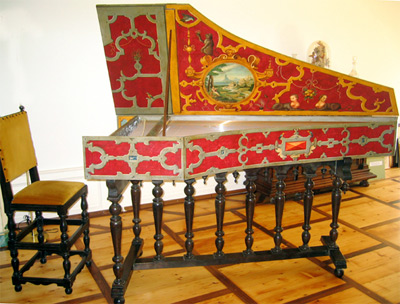Harpsichord & Piano
Harpsichord
The harpsichord dates back to the late thirteenth century and was very popular during the Baroque period. The harpsichord is essentially a keyboard; as a key is pressed, the corresponding string is plucked causing the vibration. Most harpsichords are shaped like grand pianos, with the body being roughly a triangular shape to accommodate the long bass strings on the left and the shorter treble strings on the right.
Since the harpsichord strings are plucked, no matter how hard the keys are pressed, the sound will always be the same volume. In some cases a harpsichord would have more than one string for each note and a series of jacks are used to "turn off" some sets of strings. This gives the performer some additional control over the sound.
Study the image provided and listen to the sound sample of the harpsichord to gain an understanding of this instrument.
![]() Listen to a sample of the harpsichord:
Listen to a sample of the harpsichord:

Piano
During the eighteenth century, harpsichord use started to decline when the piano became more popular. The piano was invented in 1709 by Bartolomeo Cristofori, a harpsichord builder in Italy. The instrument has been modified many times over the years, but the standard piano now has 88 keys and three pedals. Pedals are used to alter the music either making it sound softer or more sustained.
The instrument was originally called the pianoforte, which referred to its ability to produce notes at various dynamic levels (volumes). This is possible because on the piano, strings are struck with hammers and not plucked like those on the harpsichord.
Most pianos come in one of two configurations—the grand piano and the upright piano. On grand pianos the strings and frames are horizontal and range from four to nine feet in length. Upright pianos are more compact because the strings and frame are vertical.
Study the image provided and listen to the sound sample of the piano to gain an understanding of this instrument.
![]() Listen to a sample of the piano:
Listen to a sample of the piano:
